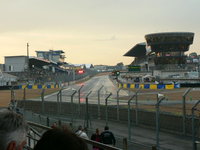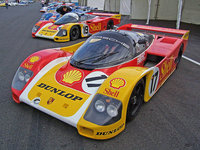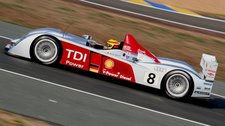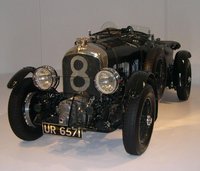Difference between revisions of "24 Hours of Le Mans"
m |
m |
||
| (6 intermediate revisions by the same user not shown) | |||
| Line 1: | Line 1: | ||
| − | |||
{{X}} | {{X}} | ||
{| border=1 cellspacing=3 cellpadding=4 style="float:right; margin:0 0 .5em 1em; width:250px; background:#505050; border-collapse:collapse; border:1px solid #999; font-size:83%; line-height:1.5; " summary="Infobox Automobile" | {| border=1 cellspacing=3 cellpadding=4 style="float:right; margin:0 0 .5em 1em; width:250px; background:#505050; border-collapse:collapse; border:1px solid #999; font-size:83%; line-height:1.5; " summary="Infobox Automobile" | ||
| Line 5: | Line 4: | ||
| colspan=2 style="padding:0; background:#333333; color:#fff; border-bottom:1px solid #999;" |[[Image:autosportlemans.jpg|250px|1952 Le Mans race, depicted on cover of ''Auto Sport Review'' magazine.]] | | colspan=2 style="padding:0; background:#333333; color:#fff; border-bottom:1px solid #999;" |[[Image:autosportlemans.jpg|250px|1952 Le Mans race, depicted on cover of ''Auto Sport Review'' magazine.]] | ||
|- style="color:#fff; background:darkred; font-size:larger;" | |- style="color:#fff; background:darkred; font-size:larger;" | ||
| − | ! colspan=2 |''' | + | ! colspan=2 |'''24 Hours of Le Mans''' |
|- | |- | ||
| Category || Endurance | | Category || Endurance | ||
| Line 21: | Line 20: | ||
| Website || [http://www.lemans.org/24heuresdumans/pages/accueil_gb.html www.lemans.org] | | Website || [http://www.lemans.org/24heuresdumans/pages/accueil_gb.html www.lemans.org] | ||
|} | |} | ||
| + | ''For the motorcycle endurance event [[24 Hours of Le Mans (motorcycle race)]]'' | ||
| + | [[Image:LeMans PitStop2.JPG|thumb|230px|right|The [[pit stop|pit]]s at dawn.]] | ||
| + | |||
| − | |||
The '''24 Hours of Le Mans''' (''24 Heures du Mans'') is a [[sports car racing|sports car]] [[endurance racing|endurance race]] held annually since {{24hLM|1923}} near the town of [[Le Mans]], [[Sarthe]], [[France]]. Commonly known as the '''Grand Prix of Endurance''', it is organised by the [[Automobile Club de l'Ouest]] (ACO) and runs on a [[Circuit de la Sarthe|circuit]] containing closed public roads that are meant not only to test a car and driver's ability to be quick, but also to last over a 24-hour period. | The '''24 Hours of Le Mans''' (''24 Heures du Mans'') is a [[sports car racing|sports car]] [[endurance racing|endurance race]] held annually since {{24hLM|1923}} near the town of [[Le Mans]], [[Sarthe]], [[France]]. Commonly known as the '''Grand Prix of Endurance''', it is organised by the [[Automobile Club de l'Ouest]] (ACO) and runs on a [[Circuit de la Sarthe|circuit]] containing closed public roads that are meant not only to test a car and driver's ability to be quick, but also to last over a 24-hour period. | ||
| Line 146: | Line 147: | ||
Alternative fuel sources would also play a part in more normal engine designs, with the first non-[[gasoline]] car appearing in {{24hLM|1949}}. The Delettrez Special would be powered by a [[diesel engine]], while a second diesel would appear in the form of the M.A.P. the following year. Although diesel would appear at other times over the race existence, it would not be until 2006 when a major manufacturer, [[Audi]], would invest in diesels and finally succeed, with the [[Audi R10 TDI|R10 TDI]]. | Alternative fuel sources would also play a part in more normal engine designs, with the first non-[[gasoline]] car appearing in {{24hLM|1949}}. The Delettrez Special would be powered by a [[diesel engine]], while a second diesel would appear in the form of the M.A.P. the following year. Although diesel would appear at other times over the race existence, it would not be until 2006 when a major manufacturer, [[Audi]], would invest in diesels and finally succeed, with the [[Audi R10 TDI|R10 TDI]]. | ||
| − | [[Ethanol fuel]] appeared in {{24hLM|1980}} in a modified [[Porsche 911]], taking a class win. Alternative biological fuel sources would return again in {{24hLM|2004}} with Team Nasamax's DM139-[[Judd (engine)|Judd]]. | + | [[Ethanol fuel]] appeared in {{24hLM|1980}} in a modified [[Porsche 911]], taking a class win. Alternative biological fuel sources would return again in {{24hLM|2004}} with Team Nasamax's DM139-[[Judd (engine)|Judd]]. In {{24hLM|2008}} the use of [[biofuels]] (10% ethanol for [[petrol]] engines and [[biodiesel]] respectively for diesel engines) were allowed. Audi was the first to use next generation 10% [[biomass to liquid|BTL]] biodiesel manufactured from [[biomass]] and developed by partner [[Royal Dutch Shell|Shell]]. |
From 2009 onwards the [http://www.racecar-engineering.com/news/people/282760/le-mans-2009-2011-regulations-released.html new Le Mans regulations] from the ACO, will allow hybrid vehicles to be entered, with either KERS or TERS setups, however the only energy storage allowed will be electrical,(i.e batteries) seemingly ruling out any flywheel based energy recovery systems. Cars equipped with KERS systems will be allowed to race in 2009 but not classified, from 2010 they can competed for points and the championship. | From 2009 onwards the [http://www.racecar-engineering.com/news/people/282760/le-mans-2009-2011-regulations-released.html new Le Mans regulations] from the ACO, will allow hybrid vehicles to be entered, with either KERS or TERS setups, however the only energy storage allowed will be electrical,(i.e batteries) seemingly ruling out any flywheel based energy recovery systems. Cars equipped with KERS systems will be allowed to race in 2009 but not classified, from 2010 they can competed for points and the championship. | ||
| Line 209: | Line 210: | ||
==External links== | ==External links== | ||
| − | + | ||
| − | * | + | * [http://www.lemans.org/24heuresdumans/pages/accueil_gb.html Le Mans official website] {{flagiconUK}} {{flagiconFrance}} {{flagiconJapan}} |
| − | + | * [http://www.radiolemans.com/ Radio Le Mans] - Le Mans history {{flagiconUK}} | |
| − | + | * [http://www.les24heures.fr Les24heuresduMans] - History of the 24 hours of Le Mans {{flagiconFrance}} | |
| − | + | * [http://www.racingsportscars.com/photo_lemans.html Racing Sports Cars] - historical photos and results {{flagiconUK}} | |
| − | + | * [http://tvschoenfilm.com/index.php?lang=eng&c=filmographie&id=11 24 Hours in Le Mans - Life at a Racing Track] - German TV documentation {{flagiconUK}} | |
| − | + | * [http://www.lemans-history.com/ lemans-history.com - The history of a Legend (Luis Santos)] {{flagiconUK}} {{flagiconFrance}} | |
Latest revision as of 23:31, 27 February 2009
| 1952 Le Mans race, depicted on cover of Auto Sport Review magazine. | |
| 24 Hours of Le Mans | |
|---|---|
| Category | Endurance |
| Country/region | |
| Inaugural | 1923 |
| Folded | |
| Drivers | 165 |
| Teams | 55 |
| Website | www.lemans.org |
For the motorcycle endurance event 24 Hours of Le Mans (motorcycle race)
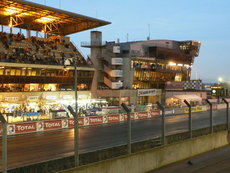
The 24 Hours of Le Mans (24 Heures du Mans) is a sports car endurance race held annually since 1923 near the town of Le Mans, Sarthe, France. Commonly known as the Grand Prix of Endurance, it is organised by the Automobile Club de l'Ouest (ACO) and runs on a circuit containing closed public roads that are meant not only to test a car and driver's ability to be quick, but also to last over a 24-hour period.
Purpose
At a time when Grand Prix racing was occurring throughout Europe, Le Mans was envisioned as a different test from motorsports at the time. Instead of focusing on the ability of a car company to build the fastest machines of the time, the 24 Hours of Le Mans would instead concentrate on the ability of manufacturers to build sporty yet reliable cars. This would drive innovation in not only reliable but also fuel-efficient vehicles, since the nature of endurance racing requires as little time to be spent in the pits as possible.
At the same time, due to the design of Le Mans, a drive would be created for better aerodynamics and stability of cars at high speeds. While this was shared with Grand Prix racing, few tracks in Europe featured straights the length of the Mulsanne. The fact that the road is public and therefore not maintained to the same quality as some permanent racing circuits also puts more of a strain on parts, causing more emphasis on reliability.
Beginning in the late 1970s, the demand for fuel economy from around the world led the race to adopt a fuel economy formula known as Group C in which competitors were given a set amount of fuel, from which they had to design an engine. Although Group C was abandoned when teams were able to master the fuel formulas, fuel economy would still be important to some teams as alternative fuel sources would appear in the early 21st century, attempting to overcome time spent during pit stops.
These technological innovations have had a trickle-down effect, with technology used at Le Mans finding its way into production cars several years later. This has also led to faster and more exotic supercars due to manufacturers wishing to develop faster road cars for the purposes of developing them into even faster GT cars.
The Race
Cars
The race field has usually consisted of approximately 50 competitors. Each car is required to have no fewer than two seats, although in recent years only the ability to place a seat in the cockpit has been understood but not enforced. No more than two doors are allowed; open cockpit cars do not require doors.
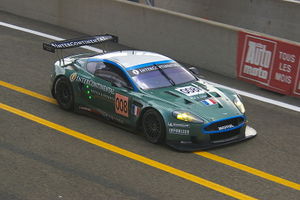
Although all cars compete at the same time, there are separate classes. An overall winner is awarded at the end of the event, while class prizes are given as well.
Classes have varied over the years, but currently there are four. Custom-built Le Mans Prototypes (LMP) are the top two classes, LMP1 and LMP2, divided by speed, weight, and power output. The next two classes are production-based grand tourer (GT) classes, also divided by speed, weight, and power output as GT1 and GT2. Although the top class is the most likely winner of the event, lower classes have won on occasion due to better reliability.
Drivers
Originally, there were no rules on the number of drivers in a car or how long they can drive. Although almost all teams used two drivers in the early decades, some Le Mans drivers like Pierre Levegh and Eddie Hall attempted to run the race themselves, hoping to save time by not having to change drivers, although this was later banned. Up until the 1980s there were teams where only two drivers competed, but by the end of the decade it was placed into the rules that at least three drivers were necessary.
By the 1990s, due to the speeds of the cars and the strain it put on drivers, further rules were put in place in order to aid in driver safety. Drivers could not drive more than four hours consecutively, and no one driver could run for more than fourteen hours total. This has reduced driver fatigue during the races.
Unique rules and traditions
Although the 24 Hours of Le Mans was part of the World Sportscar Championship for most of its existence, it has regularly had rules which differed from those used in other series, partially due to the length of the event. Some rules are for safety reasons, while others are for the purposes of competition.
For many decades, cars were required to run at least an hour into the race before they were allowed to refill fluids for the car, such as oil or coolant, with the exception of fuel. This was an attempt by the ACO to help increase efficiency and reliability. Cars which could not last the first hour without having to replace lost fluids were disqualified.
Another rule that is unique to Le Mans is a requirement for cars to be shut off while they are being refueled in the pits. Based not only the notion that it is safer and less of a fire hazard to do so, this also allows for another test of reliability, because cars have to test their ability to restart many times under race conditions. Another element of this rule is that mechanics are not allowed to work on the car or its tires while it is being refueled, which has led teams to adapt innovative ways in which to decrease the time of these lengthy pit stops. As an exception to this rule, drivers are allowed to get out of the car and be replaced by another driver during refueling.
At Le Mans there are various traditions that have been seen over the years. One of the longest lasting is the waving of the French tricolor to start the race. This is usually followed by a fly-over featuring jets trailing red, white and blue smoke. A similar flag tradition is the waving of safety flags during the final lap of the race by track marshals, congratulating the winners and other finishers.
The 24 Hours of Le Mans also saw the first known instance at a major race of a winning driver celebrating by spraying champagne instead of drinking it. When Dan Gurney won the 1967 race with co-driver A.J. Foyt, the two drivers mounted the victory stand and Gurney was handed a magnum of champagne. Looking down, he saw Ford CEO Henry Ford II, team owner Carroll Shelby and their wives, as well as several journalists who had predicted disaster for the high-profile duo. Gurney shook the bottle and sprayed everyone nearby, establishing a tradition reenacted in victory celebrations the world over for the next 40 years. Gurney, incidentally, autographed and gave the bottle of champagne to a LIFE magazine photographer, Flip Schulke, who used it as a lamp for many years. He recently returned the bottle to Gurney, who keeps it at his home in California.
Schedule
The first race was held on 26 and 27 May 1923 and has since been run annually in June, with exceptions occurring in 1956, when the race was held in July, and 1968, when it was held in September, due to nationwide political turmoils earlier that year (see May 1968). The race has been cancelled twice: once in the year 1936 (Great Depression) and from 1940 to 1948 (World War II and its aftermath).
The race weekend also usually takes place the second weekend of June, with qualifying and practice taking place on the Wednesday and Thursday before the race, following an administrative scrutinizing of the cars on Monday and Tuesday. Currently these sessions are held in the evening, with two separate two hour sessions held each night. A day of rest is scheduled on Friday, and includes a parade of all the drivers through the center of the town of Le Mans.
A test day was also usually held prior to the event, traditionally at the end of April or beginning of May. These test days served as a pre-qualification for the event, with the slowest cars not being allowed to appear again at the proper qualifying. However, with the cost necessary to transport cars to Le Mans and then back to their respective series in between the test and race weeks, the test day was moved to the first weekend of June for 2005. The notion of pre-qualifying was also eliminated in 2000, when all competitors invited to the test would be allowed into the race.
The Le Mans Legend races have also been part of the schedule since 2001, usually running exhibition races during qualifying days, a few hours prior to the sessions for the Le Mans entrants.
Traditionally, the race starts at 16:00 on the Saturday, although in 1968 the race started at 14:00 due to the lateness of the race on the calendar. In both 1984 and 2007, the start time was moved ahead to 15:00 due to the conflicting French General Election. In 2006, the ACO scheduled a 17:00 start time on Saturday, 17 June in order to maximize television coverage in between the FIFA World Cup games. Discussions are being held that may see the regular start time being moved to 15:00 from 2008 onwards.
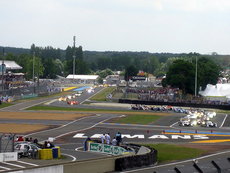
Classification
Originally, the race results were actually determined by distance. The car which covered the greatest distance was declared the winner. This is known to have caught out the Ford team in 1966. With a dominant 1-2 lead, the two cars slowed to allow for a photo opportunity at the finish line, with Denny Hulme slightly ahead of Bruce McLaren. However, since McLaren's car had actually started much farther back on the grid from Hulme, McLaren's car had actually covered the farthest distance over the 24 hours. With the margin of victory determined to be eight meters, McLaren and co-driver Chris Amon were declared the winners. This distance rule was later changed with the advent of rolling starts, leading to the winner being declared by number of laps.
To be classified in the race results, a car is required to cross the finish line after 24 hours. This has led to dramatic scenes where damaged cars wait in the pits or on the edge of the track close to the finish line for hours, then restart their engines and crawl across the line to be listed amongst the finishers. However, this practice of waiting in the pits was banned in recent years with a requirement that a team complete a set distance within the last hour to be classified.
Another rule put into place by the ACO was the requirement that cars complete 70% of the distance covered by the winner. A car failing to complete this number of laps, even if it finished the race, was not deemed worthy of classification due to the poor reliability or speed.
Le Mans start
The race traditionally began with what became known as the Le Mans start, in which cars were lined up alongside the pit wall in the order in which they qualified. The starting drivers would stand on the opposite side of the front stretch. When the French flag dropped to signify the start, the drivers would run across the track to their cars, which they would have to enter and start without assistance, before driving away. This became a safety issue in the late 1960s when drivers would ignore their safety harnesses, a recent invention. This led to drivers running the first few laps either improperly harnessed due to attempting to do it while driving or sometimes not even harnessed at all, leading to several deaths when cars were involved in accidents due to the bunched field at the start.
This starting method inspired Porsche to locate the ignition key switch to the left of the steering wheel. This allowed the driver to use his left hand to start the engine, and his right hand to put the transmission into gear. This location of the ignition key switch is still found today on many Porsche models.
Feeling this type of start was unsafe, the 1969 event saw Le Mans rookie Jacky Ickx oppose the method by walking across the track while his competitors ran. Although nearly hit by a faster competitor's car while walking, Ickx took the time to fasten his safety belts before pulling away. Sadly, the first lap of that race saw privateer racer John Woolfe killed in an accident, while Ickx would go on to win the race.
The traditional Le Mans practice was altered for 1970. Cars were still lined up along the pit wall, but the drivers were already inside and strapped in. At the dropping of the French tricolor, the drivers would then start their engines and drive away. However, in 1971 this method would be done away with altogether as a rolling start (sometimes known as an Indianapolis start) was introduced, which has been used ever since.
The circuit
Template:Main The circuit on which the 24 Hours of Le Mans is run is named the Circuit de la Sarthe (Circuit of the Sarthe), after the Sarthe department that Le Mans is within. It consists of both permanent track and public roads that are temporarily closed for the race. Since 1923 the track has been extensively modified, mostly for safety reasons, and currently is 13.65 km in length. Although it initially entered the town of Le Mans, the track was cut short in order to better protect spectators. This led to the creation of the Dunlop Curve and Tertre Rouge corners before rejoining the old circuit on the Mulsanne. Another major change was on the Mulsanne itself, when the FIA decreed that it would no longer sanction any circuit which had a straight longer than 2 km. This led to the addition of two chicanes, slowing the high speeds that cars had been capable of reaching on the old five km long straight.
The public sections of the track differ from the permanent circuit, especially in comparison to the Bugatti Circuit which is inside the Circuit de la Sarthe. Due to heavy traffic in the area, the public roads are not as smooth or well kept. They also offer less grip because of the lack of soft tyre rubber laid down from racing cars, though this only affects the first few laps of the race. The roads are closed only within a few hours of the practice sessions and the race, before being opened again almost as soon as the race is finished. Workers have to assemble and dismantle safety barriers every year for the public sections.
History
- For a list of individual race reports, see Category:24 Hours of Le Mans races.
1923-1939
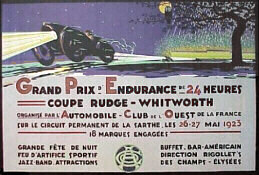
The 24 Hours of Le Mans was first run on 26 May and 27, 1923, through public roads around Le Mans. Originally planned to be a three year event awarded the Rudge Whitworth Triennial Cup, with a winner being declared by the car which could go the farthest distance over three consecutive 24 Hour races, this idea was abandoned in 1928 and overall winners were declared for each single year depending on who covered the farthest distance by the time 24 hours were up. The early races were dominated by French, British, and Italian drivers, teams, and cars, with Bugatti, Bentley, and Alfa Romeo being the dominant marques. Innovations in car design began appearing at the track in the late 1930s, with Bugatti and Alfa Romeo running highly aerodynamic bodywork in order to run down the Mulsannes Straight at faster speeds. In 1936 the race was cancelled due to general strikes in France, then with the outbreak of World War II in late 1939, the race went on a ten year hiatus while France reconstructed itself.
1949-1969
Following the reconstruction of the circuit facilities, the race was resumed in 1949 with renewed interest from major automobile manufacturers. After the formation of the World Sportscar Championship in 1953, of which Le Mans was a part, Ferrari, Aston Martin, Mercedes-Benz, Jaguar, and many others began sending multiple cars backed by their respective factories to compete for overall wins against their competitors. Unfortunately this fierce competition would also lead to tragedy with an accident during the 1955 race in which the car of Pierre Levegh crashed into the crowd of spectators, killing more than 80 people. This led to widespread safety measures being brought into place not only at the circuit, but elsewhere in the motorsports world. However, even though the safety standards improved, so did the speeds of the cars. The move from open-cockpit roadsters to closed-cockpit coupes would help produce speeds over 320 km/h on the Mulsanne. Race cars of the time were still mostly based on production road cars, but by the end of the 1960s, the Ford Motor Company would enter the picture with their GT40s, taking four straight wins before the era of production-based wins would come to a close.
1970-1981
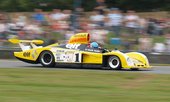
For the new decade, the race took a turn towards more extreme speeds and automotive designs. These extreme speeds led to the replacement of the typical standing Le Mans start with a rolling Indianapolis start. Although production-based cars still raced, they were now in the lower classes while purpose-built sportscars become the norm. The Porsche 917, 935, and 936 were dominant throughout the decade, but a resurgence by French manufacturers Matra-Simca and Renault saw the first victories for the nation since the 1950 race. This decade is also remembered for strong performances from many privateer constructors, with two scoring the only victories for a privateer. John Wyer's Mirage won in 1975 while Jean Rondeau's self-titled chassis took 1980.
1982-1993
The rest of the 1980s was known for the dominance by Porsche under the new Group C race car formula which pushed for fuel efficiency. Originally running the effective 956, it was later replaced by the 962. Both chassis were cheap enough for privateers to purchase them en masse, leading to the two chassis winning six years in a row. Jaguar and Mercedes-Benz returned to sports car racing, with Jaguar being the first to break Porsche's dominance with victories in 1988 and 1990 (with the XJR-9 and Jaguar XJR-12 respectively). Mercedes-Benz also won in 1989 with what was seen as the latest incarnation of the elegant "Silver Arrows", the Sauber C9, while an influx of Japanese manufacturer interest saw prototypes from Nissan and Toyota. However, Mazda's unique rotary-powered 787B would be the only manufacturer to succeed, winning in 1991. For 1992 and 1993, Peugeot entered the sport and dominated the race with the Peugeot 905 as the Group C formula and World Sportscar Championship were fading in participation.
The circuit would also undergo one of its most notable changes in 1990, when the 5 km long Mulsanne was modified to include two chicanes in order to stop speeds of upwards of 386 km/h from being reached. This began a trend by the ACO to continually attempt to slow portions of the track down, although speeds over 320 km/h are still regularly reached at various points on a lap.
1994-1999
Following the demise of the World Sportscar Championship, Le Mans saw a resurgence of production-based grand tourer cars. Thanks to a loophole in the rules, Porsche was successfully able to convince the ACO that a Dauer 962 Le Mans supercar was a production car, allowing Porsche to race their Porsche 962 for one final time, dominating the field. Although the ACO attempted to close the loop hole for 1995, newcomer McLaren would win the race in their supercar's first appearance thanks to reliability, beating faster yet more trouble prone prototypes. The trend would continue through the 1990s as more exotic supercars were built in order to skirt the ACO's rules regarding production-based race cars, leading to Porsche, Mercedes-Benz, Toyota, Nissan, Panoz, and Lotus entering the GT categories. This culminated in the 1999 event, in which these GT cars were faced with the Le Mans Prototypes of BMW, Audi, and Ferrari. BMW would survive with the victory, their first ever.
This strong manufacturer influence led the ACO to lending the Le Mans name to a sports car series in the United States in 1999, known as the American Le Mans Series, which competes to this day and serves to qualify teams to enter Le Mans.
2000-2007
Following the 1999 event, many major automobile manufacturers would pull out of sports car racing due to the costs associated with running the event. Among them, only Cadillac and Audi would remain, with Audi easily dominating the race with their R8. Cadillac would pull out of the series after three years and although Panoz, Chrysler, and MG would all briefly attempt to take on Audi, none could match the R8's performance. After three victories in a row, Audi provided engine, team staff and drivers to their corporate partner Bentley, who had returned in 2001, and the factory Bentley Speed 8s were able to succeed ahead of privateer Audis in 2003. At the end of 2005, after five overall victories for the R8, and six to its V8 turbo engine, Audi took on a new challenge by introducing a diesel engined prototype known as the R10 TDI. Although not the first diesel to race, it was the first to achieve victory at Le Mans. This era saw other alternative fuel sources being used, including bio-ethanol, while Peugeot decided to follow Audi's lead and also pursue a diesel entry in 2007 with their 908.
A second ACO-backed series was also formed, similar to the American Le Mans Series, but concentrating on Europe. The Le Mans Endurance Series (later shortened to Le Mans Series), would resurrect many well known 1000 km endurance races. This would later be followed by the Asian centered Japan Le Mans Challenge in 2006.
Innovations
Over its lifetime, Le Mans has seen many innovations in automotive design in order to counteract some of the difficulties that the circuit and race present. These have either been dictated by rules or have been attempts by manufacturers to outwit the competition. Some have made their way into the common automobile and are used nearly every day.
Aerodynamics
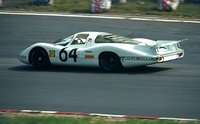
One of the keys to Le Mans is top speed, caused by the long straights that dominate the circuit. This has meant cars have attempted to achieve the maximum speeds possible instead of relying on downforce for the turns. While early competitors cars were street cars with their bodywork removed to reduce weight, innovators like Bugatti developed cars which saw the beginnings of aerodynamics. Nicknamed tanks due to their similarity to a drop tank, these cars used simple curves to cover all the mechanical elements of the car and increase top speed. Once Le Mans returned after World War II, most manufacturers would adopt closed bodies which were streamlined for better aerodynamics. This led to a separation from Grand Prix cars, which rarely had large bodywork.
As the years went on, bodywork became larger while at the same time lighter. The larger bodywork was able to provide more downforce for the turns without increasing the drag, allowing cars to maintain the high top speeds. These extended bodyworks would usually concentrate on the rear of the car, usually being termed long tail. The bodywork also began to cover the cockpit for less drag, although open cockpits would come and go over the years as rules varied. Aerodynamics reached its peak in 1989 before the Mulsanne Straight was modified. During the 1988 race, the crew of a W.M. prototype taped over the engine openings and set a recorded speed of 404 km/h (251 mph) down the Mulsanne in an attempt for some publicity, although the car was nearly undrivable elsewhere on the circuit and the engine was soon destroyed from a lack of cooling. However, for the 1989 event, the Mercedes-Benz C9 reached 399 km/h (248 mph) under qualifying conditions.
Engines
A wide variety of engines have competed at Le Mans, in attempts to not only achieve greater speed but also to have better fuel economy, and spend less time in the pits. Engine sizes have also varied greatly, with the smallest engines being a mere 569 cc (Simca Cinq) and the largest upwards of 7986 cc (Chrysler Viper GTS-R). Supercharging was an early innovation for increasing output, first being raced in 1929, while turbocharging would not appear until 1974.
The first car to enter without an engine run by pistons would be in 1963, when Rover partnered with British Racing Motors to run a gas turbine with mixed success, repeating again in 1965. The American Howmet Corporation would attempt to run a turbine again in 1968 with even less success. Although the engines offered great power, they were notoriously hot and uneconomical for fuel.
Another non-piston engine that would appear would be a Wankel engine, otherwise known as the rotary engine. Run entirely by Mazda since its introduction in 1970, the compact engine would also suffer from fuel economy problems like the turbine had, yet would see the success that the turbine lacked. After many years of development, Mazda finally succeeded in being the only winner of the race to not have a piston-powered engine, taking the 1991 event with the 787B.
Alternative fuel sources would also play a part in more normal engine designs, with the first non-gasoline car appearing in 1949. The Delettrez Special would be powered by a diesel engine, while a second diesel would appear in the form of the M.A.P. the following year. Although diesel would appear at other times over the race existence, it would not be until 2006 when a major manufacturer, Audi, would invest in diesels and finally succeed, with the R10 TDI.
Ethanol fuel appeared in 1980 in a modified Porsche 911, taking a class win. Alternative biological fuel sources would return again in 2004 with Team Nasamax's DM139-Judd. In 2008 the use of biofuels (10% ethanol for petrol engines and biodiesel respectively for diesel engines) were allowed. Audi was the first to use next generation 10% BTL biodiesel manufactured from biomass and developed by partner Shell.
From 2009 onwards the new Le Mans regulations from the ACO, will allow hybrid vehicles to be entered, with either KERS or TERS setups, however the only energy storage allowed will be electrical,(i.e batteries) seemingly ruling out any flywheel based energy recovery systems. Cars equipped with KERS systems will be allowed to race in 2009 but not classified, from 2010 they can competed for points and the championship.
Brakes
With increased speeds around the track, brakes become a key innovation for teams attempting to safely bring their cars down to a slow enough speed to make turns such as Mulsanne Corner. Disc brakes were first seen on a car when the Jaguar C-Type raced at Le Mans in 1953. The Mercedes-Benz 300 SLR would introduce the concept of an air brake in 1955, using a large opening hood on the rear of the car.
In the 1980s, anti-lock braking systems would become standard on most Group C cars as a safety measure, ensuring that cars did not lose control while still moving at approximately 320 km/h. By the late 1990s, reinforced carbon-carbon brakes would be adapted for better stopping power and reliability.
Successful marques and drivers
- For a list of winning drivers, teams, and cars, see List of 24 Hours of Le Mans winners.
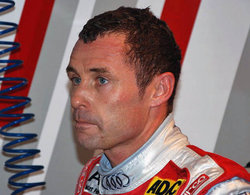
Over the years, many manufacturers have managed to take the overall win, while even more have taken class wins. By far the most successful marque in the history of the race is Porsche, who have taken 16 overall victories, including seven in a row from 1981 to 1987. Ferrari follows with nine, also including six in a row from 1960 to 1965, while Jaguar has seven wins. Bentley, Alfa Romeo, and Ford all managed to win four races in a row, with Bentley recording two other victories in other years as well. Recently the Audi marque has dominated the event, winning in eight of the ten years they have participated. Audi and Team Joest have had two hat-tricks, the first being in 2000, 2001, and 2002. The only Japanese marque to win the race so far has been Mazda, although nearly every major Japanese manufacturer has made attempts at the race. Mazda's 1991 victory also saw the only win by a rotary engine, one of Mazda's hallmarks.
For drivers, two drivers stand apart for their number of victories. Initially Jacky Ickx held the record at six, scoring victories between 1969 and 1982, earning him an honorary citizenship to the town of Le Mans. However newcomer Tom Kristensen has been able to quickly eclipse this record with eight wins between 1997 and 2008, including six in a row. Three-time winner Woolf Barnato is still the only driver to have won every Le Mans he has participated in, from 1928 to 1930.
Henri Pescarolo has won the race four times, yet currently holds the record for the most Le Mans appearances at 33. Japan's Yojiro Terada, currently still active as a driver, holds the record for the most Le Mans starts without a win.
Accidents
Main Article List of 24 Hours of Le Mans fatal accidents
With the high speeds associated with Le Mans, the track has seen a number of accidents, some of which have been fatal to drivers and spectators. The worst moment in Le Mans history was during the 1955 race in which more than 80 spectators and driver Pierre Levegh were killed. In the shock following this disaster, many major and minor races were cancelled in 1955, such as the Grand Prix races in Germany and Switzerland, the latter banning motorsport throughout the entire country. This accident brought wide sweeping safety regulations to all motorsports series, for both driver and spectator protection. In 1986 Jo Gartner drove a Porsche 962C and crashed into the barriers on the Mulsanne straight, killing him instantly. His accident was the most recent fatality in the race itself, however there was a fatality in 1997 during the practices.
In one of the most recognizable recent accidents, calamity would once again strike Mercedes-Benz, although without fatality. The Mercedes-Benz CLRs which competed in 1999 would suffer from aerodynamic instabilities that caused the cars to become airborne in the right conditions. After initially happening at the Le Mans test day, Mercedes claimed they had solved the problem, only to have it occur again at Warm Up hours before the race. Mark Webber was the unlucky driver to flip the car on both occasions. The final and most damaging accident occurred during the race itself when Peter Dumbreck's CLR became airborne and then proceeded to fly over the safety fencing, landing in the woods several metres away. No drivers were badly hurt in any of the three accidents, but Mercedes-Benz quickly withdrew their remaining entry and ended their entire sportscar program.
Appearances in media
The 1969 event, known for its close finish, was documented in a short film entitled La Ronde Infernale. This was given a limited cinema release but is now available on DVD.
The race became a major motion picture in 1971 when Steve McQueen released his simply titled Le Mans, starring McQueen as Michael Delaney, a driver in the 1970 event for the Gulf Porsche team. Likened to other motorsports films such as Grand Prix for Formula One racing and Winning for the Indianapolis 500, Le Mans is the best known film to center on sports car racing. It was filmed during the race using modified racing cars carrying cameras, as well as purchased Porsche 917s, Ferrari 512s and Lola T70s for action shots made after the race. The Porsche 908 which served as a camera car in the race actually finished, yet was so far behind the winners due to lengthy reel changes during pit stops that it was not classified in the results.
A modern film not centering on Le Mans yet featuring events from the 2002 race was Michel Valliant, about a French comic book motorsports hero. Again using two camera cars to tape action during the race, the French film was not as widely accepted as Le Mans had been. The 1974 TV show The Goodies also featured an episode entitled The Race, involving a comedic trio attempting to run Le Mans.
The race has also been used for several video games over the years, some of which have allowed players to compete for the full 24 hours. Although most used the Le Mans name itself, the PlayStation 2 game Gran Turismo 4 also included the Circuit de la Sarthe and allowed players to run the full 24 hour races with and without the chicanes on the Mulsanne Straight. The Xbox 360 and Playstation 3 game Race Driver: GRID also includes the 24 Hours of Le Mans at the end of each in-game season albeit being only 24 minutes in length. However the player can also choose to compete in the race for different lengths of time ranging from several minutes to a full 24 hours.
Coverage
Motors TV covered the Le Mans 24 Hours in the entirety in 2006 and 2007. This included coverage of the scrutineering, qualifying, driver parade, warm up and the whole race. In the United States, Speed Channel airs partial live coverage through a combination of coverage from the French host broadcaster and their own pit reporting crew. In 2008 Eurosport secured a multi-year deal to show the entire race including the qualifying and the motorcycle race. Every hour of the 2008 race was broadcasted in segments on the main channel and on Eurosport 2. In addition live streaming video was provided on Eurosport's web page, albeit not for free.
The race is also broadcast (in English) on radio by Radio Le Mans. Broadcast from the circuit for the full 24 hours as well as before and after, it offers fans at the race the ability to listen to commentary through radio. Radio Le Mans is also broadcast through internet radio on their website, or on the GlobeCast Radio channel on Sky Digital.
Vintage racing
Main Article Le Mans Legend
Since 2001, the ACO has allowed the Le Mans Legend event to participate on the full Circuit de la Sarthe during the 24 Hours week. These exhibition races involve classic cars which had previously run at Le Mans or similar to ones that had. Each year, a set era of cars is allowed to participate, with the era changing from year to year. Though mostly amateur drivers, some famous drivers have appeared to race cars they had previously run, such as Stirling Moss.
Template:Main Starting in 2002, the Le Mans Classic has taken place on the full 13 km circuit in July, as a biannual event. The races take places over a full 24 hour day/night cycle, with starts on set times allowing cars from the same era to compete at the same time. A team typically consists of a car in each class, and the team with the most points accumulated over five or six classes declared the overall winner. The classes are based on the era in which the cars would have competed, the exact class requirements are re-evaluated for every event since for every event the age for the youngest entries is shifted by 2 years. Although the format of the first event saw 5 classes doing more short races, later events have seen 6 classes do less but longer races. With the upcoming 2008 event probably allowing early Group C contenders, this format could see yet another revision with either more classes or classes spanning longer periods in time. Drivers are also required to have an FIA International Competition license to participate. This event also includes a large concours and auction.
See also
- List of 24 Hours of Le Mans winners
- Endurance racing
- Le Mans 24 Hours video games
- 24 Hours of Le Mans (motorcycle race)
- 24 Hours of LeMons
References
- Le Mans 1965 in Automobile Historique n°48 May 2005 (in French)
- 24 heures du Mans 1973 in Automobile Historique n°49 June/July 2005 (in French)
External links
- Le Mans official website



- Radio Le Mans - Le Mans history

- Les24heuresduMans - History of the 24 hours of Le Mans

- Racing Sports Cars - historical photos and results

- 24 Hours in Le Mans - Life at a Racing Track - German TV documentation

- lemans-history.com - The history of a Legend (Luis Santos)


| 24 Hours of Le Mans · 24 Hours Nürburgring · Rolex 24 at Daytona · Spa 24 Hours · 24 Hours of Zolder · Tokachi 24 hour · Britcar 24hr Race · Willhire 24 Hour · Bathurst 24 Hour |
